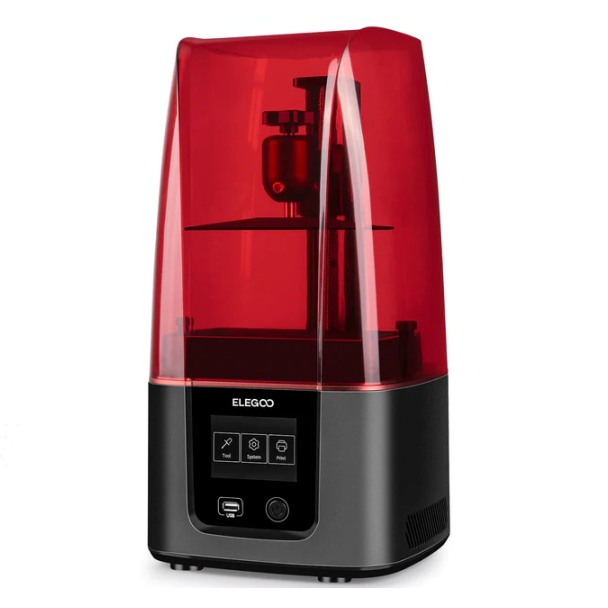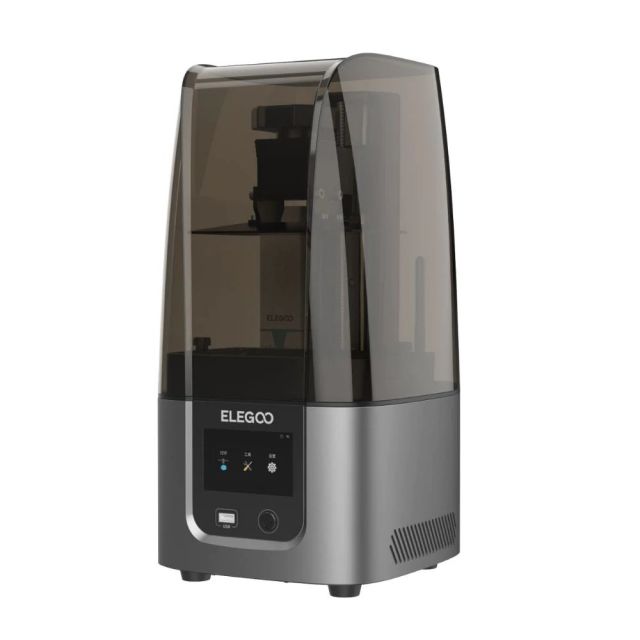3D Resin Printing: Things you'll need to print with resin
The printer
 The obvious one is a 3D printer. I won't go into the different printers too much here as they're all very similar and have their own advantages and disadvantages. You can't really go wrong with any of the lower-end resin printers on the market, though. Elegoo Mars, Phrozen, Photon, Creality, so it's really down to your preference and way of working. As mentioned, each one will have pros and cons and slightly different ways of working. My main 3D resin printer nowadays is an Elegoo Mars 3. I use this printer for various reasons:
The obvious one is a 3D printer. I won't go into the different printers too much here as they're all very similar and have their own advantages and disadvantages. You can't really go wrong with any of the lower-end resin printers on the market, though. Elegoo Mars, Phrozen, Photon, Creality, so it's really down to your preference and way of working. As mentioned, each one will have pros and cons and slightly different ways of working. My main 3D resin printer nowadays is an Elegoo Mars 3. I use this printer for various reasons:-
Great speed and quality for the cost. Sub £400 and typically it takes 2-3 seconds per layer. It's well built and has a 4k mono LCD for extra detail and longer life,
-
It uses chitubox which is a decent slicer. The .ctb file format it uses is well documented and hacked, meaning there are lots of excellent tools and resources online,
-
It comes with a free year of Chitubox Pro. The Pro version isn't needed (it's usually pay-years subscription) but it is nice to have for the extra features,
-
It's relatively easy to setup and maintain. Most problems you'll experience are very likely user error and very easy to correct.
The essentials
Now that we've covered the printer, lets cover everything that you need to go along with your new printer. Most printers will come with what they claim are the bare essentials but it's definitely lacking. Lets cover the things you're need to even begin printing:
Safety glasses
The printer doesn't come with any, and you do not want the resins or IPA alcohol in your eye. Both are painful and cured resin in your eye can cause lasting damage. They're cheaper than your eyesight.
Respirator
You'll want something like a 3M Dual cartridge respirator. The resin gives off noxious fumes that are better not-breathed-in. This is also handy for airbrushing and painting.
Nitrate gloves
Buy them in packs of 500-1000. The printer comes with some, but you'll use them quickly. They're also great for airbrushing/painting so won't go to waste or just be used for printing. Get the right size and not to big, or you increase chance of making a mess.
Liter bottles of 99% IPA
You'll need these to clean your print. I always tend to have 2 or 3 bottles spare as you can get it much cheaper in bulk. Remember to store outside - it's extremely flammable and can be explosive and dangerous.
Air-tight plastic container for IPA
I use food storage ones with the rinse inset. You can place your printed piece in and use this inset to jiggle it about and clean it, and fish out the print.
Spare empty 1.5-2l soda bottles
The IPA you clean with slowly gets dirtier and dirtier and should be changed. I move my contaminated IPA/resin mixture into these and let them cure outside. I'll dispose of these at a waste disposal nearby in batch now and then.
Large pack of green paper towels
The kind you find in public bathrooms. I rest the build plates on these when taking them out, clean up spills, dry off IPA-washed-pieces. Buying these in bulk is much cheaper and you'll go through them quickly. You an use regular kitchen paper towels, but I tend to find the fibres of those get stuck to the print or in the tray.
Decent USB stick for printer
Most of the printers you buy come with one, but it can be a bit hit and miss as to whether they're any good. Cheap USB sticks can cause errors with prints mid-way-through. Luckily the Phrozen Mini 4k came with a Sandisk USB stick so i didn't need to buy an extra one.
Plastic funnels
I have a pack of different-sized plastic funnels. These are for transfering resin and IPA between small-necked containers without spilling. Filter inlay can also be put in funnel to filter out tray resin.
Nice to have
The following are not really essential, but are on the nice-to-have list. They'll make resin printing much tidier, safer and easier in general.
UVtools
UVtools is a free piece of software that opens many resin printing formats (CTB included). It will scan the print for errors, tell you when you have unsupported parts of a model, identify areas where resin will get trapped and let you do all kinds of nifty things (merge two CTB, move prints around, hollow them, etc.). It can definitely save you from the headache of failed prints by identifying issues that could happen before you start.
USB extension cable
Prevents long-term usage from damaging a hard-to-replace built in USB port on your printer (just have to replace extension cable later on if anything happens). Also means that you're not fiddling around trying to push your USB stick in the back/side of the printer all the time.
Plastic spray bottle
This is handy for putting some IPA in to spray surfaces and parts. You can buy 99% IPA containers with built in spray bottles, or you can buy an empty one and fill it yourself.
Spare FEP film
Most printers come with 1-2 spare layers of FEP film, but you'll definitely be at an advantage having more. It's very easy to accidentally scratch or piece the resin tray film and it's good to have some ready to replace.
Spare paper resin filters
Again, most printers come with a few spare filters, but you'll go through these quickly. Found on Amazon as paint strainer mesh filters.
Screen/lens wipes
Good for periodically cleaning the LCD screen. I have found that IPA can make it a bit cloudy, whereas screen/lens wipes don't.
Microfibre clothes
To go with the above, microfibre clothes are great for drying the screen once you've wiped it as they don't leave small fibres and bits of fluff like paper towels can.
Roll of parchment paper
I lay a sheet onto my work space at the start just to catch any resin spills missed by the towels. Easy to take up at the end of the day and bin. An optional extra to this is a non-porous surface (glass/plastic chopping board). Makes your work surface portable, and easier to clean than a wooden worksurface.
Curing station
You can use a salon nail curing station to cure 3D Printers. Just make sure that it specifies it cures in the 405nm frequency range. This means you don't need to rely on it being nice outside (or it being daytime) after printing. Can be converted with a reflective box to make into a proper curing station.
Matte varnish
Good for sealing a model once it's cured and prevents both resin exposure on your skin, and firther UV exposure to the print. You can get something like Mr Hobby UV matte layer that will stop UV further curing the model.
Model sprue cutters/clippers and craft knife
Used to remove the support structures. I bought a generic model building kit. You'll want to keep these seperate as it will be touching resin that you want to try to prevent spreading around.
A 1000 ml airtight (important) locking plastic container
Instead of emptying my resin at the end of the day back into the container, I store the entire vat with resin inside the airtight container in a dark cupboard. Prevents smell escaping, dust getting in and reduces resin waste from having to tip between containers. Also means I don't have to clean lots of funnels, etc.
Pack of disosable business cards
I ordered a super-cheap pack of 1000 businesses cards off of somewhere like vista-print that I use to stir the resin in the tray, poke stuck prints off the film or stand the prints on to cure so I don't touch them. Also great for use as an airbrush mask, so not just wasted on 3D printing.
Eyewash kit
Again - your eyesight is valuable. You'll hopefully never need to use this, but it's better to have it there just in case you do get IPA or resin in your eye.
Investigate resins
Most printers come with some resin to get your started. It will, however, only be a smaller bottle and it will likely be quite smelly (especially Anycubic's) and some can cause irritations to your skin. Not so bad if you have a well ventilated room and use gloves, but there are resins out there with very little smell and differ in toxicity.
A storage shed or garage
Lastly, somewhere out the way to store your byproducts of printing. This'll be contaminated towels, prints and gloves, resin/IPA mixtures in soda bottles, and a good idea to store the 99%, hightly-flammable IPA in here.
Updates to this entry
-
April '23
Updated 'The printer' section with my latest hardware,
-
April '21
Updated 'The printer' section with my latest hardware,
Added UVTools to the list of nice things to have
3D Resin Printing

Part of the '3D Resin Printing' series.
Things I've learnt during the process of 3D Printing with resin
Related by tags
3dprintingElegoo Mars 4 Ultra
"Gamepig" from System Shock Remake
March 7th Camera from Honkai Star Rail
"Gamepig" from System Shock 2
Astral Express from Honkai Star Rail
US 'Truman Bobcat' from Battlezone
Icarus from Quake 2
Silent Hill 2 - Pyramid Head Minifig
Technician from Quake 2
US Tug from Battlezone
articles3D Resin Printing: Replacing a Mars 3 LCD
3D Resin Printing: Storing resin between prints
Who I am
I'm Blake and I like to tinker with things and make stuff. When I'm not programming or developing random systems, I'm playing with electronics, doodling bits of art, 3D modelling or sculpting and painting things or nerding out watching sci-fi or horror TV.
From 2001 I worked in the games industry, eventually specialising in tools to aid in the development of video games and their engines. In 2011 I left the industry and teamed up with a few other talented composers to utilise my knowledge to help build the company 'Spitfire Audio'.
I also periodically compose soundtracks for video-games and have worked on titles such as The Stanley Parable and Portal Knights. You've probably also heard my music in random TV commercials at some point.
What I'm using to create

I use various bits and bobs to craft my shiz.
- Elegoo Mars 4 Ultra, Mars 3 Pro & Saturn 2 8k
- Phrozen Sonic Mighty 4k & Mini 4k
- Anycubic Photon LCD resin printer,
- Phrozen Aqua Resin Grey 4k
- Elegoo Resin Space Grey 8k
- Phrozen Luna curing station
- Vallejo Model Color, Game Air, various sets,
- Iwata Eclipse HP-CS & Studio Smart Jet Pro Compressor,
- Random cheapo airbrushes for base coats,
- 3D Studio Max, ZBrush and Chitubox Pro.